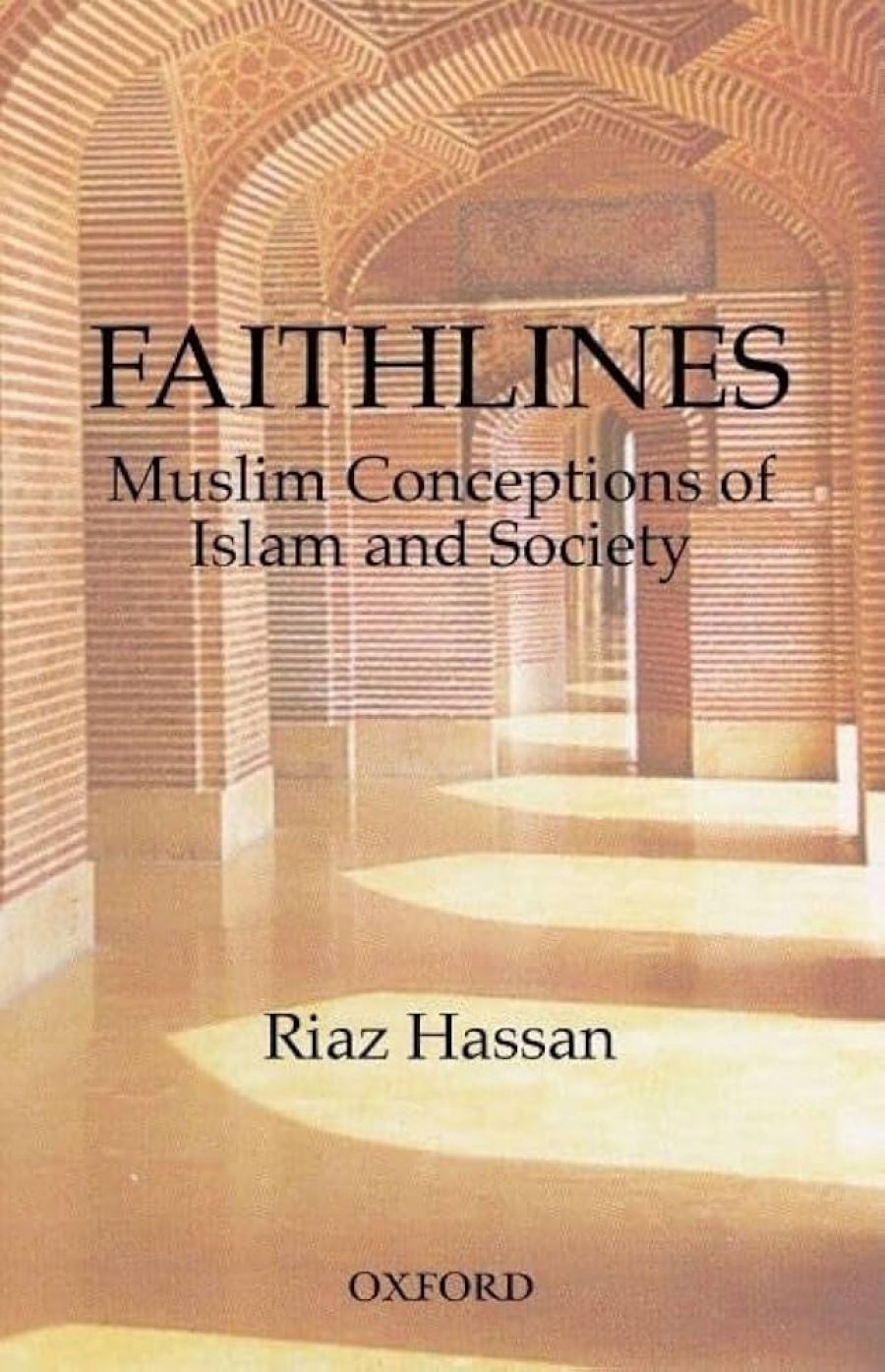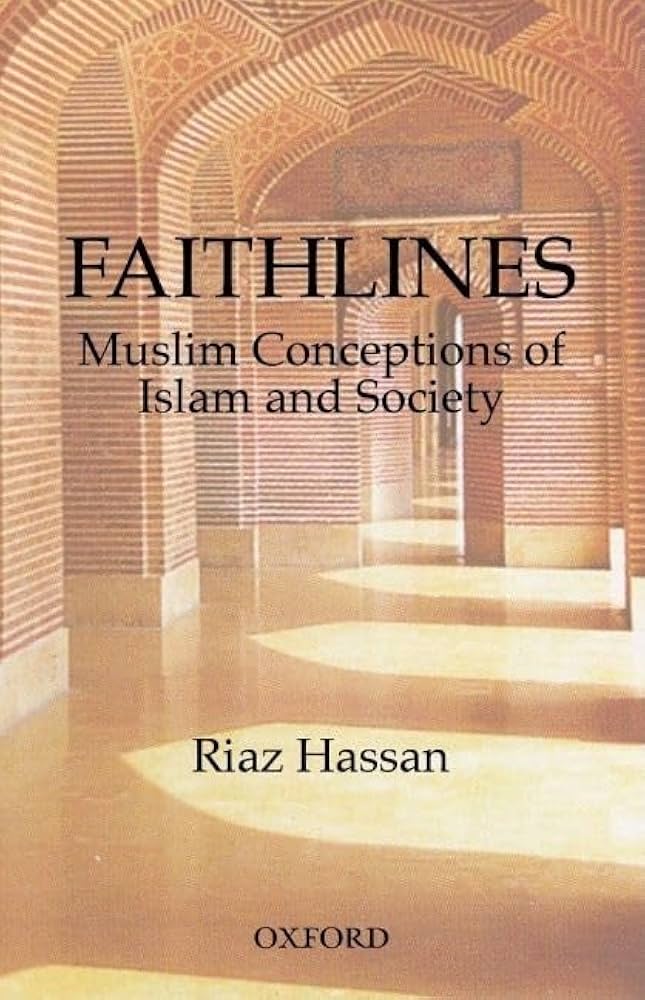
- Free Article: No
- Contents Category: Religion
- Review Article: Yes
- Article Title: Islamic Variations
- Online Only: No
- Custom Highlight Text:
This book is a study of Muslims’ perceptions of religion and society. Among the related aspects it explores are self-image and gender relations in Islam. The study is a survey-type questionnaire, carried out in four Muslim countries: Indonesia, Pakistan, Egypt and Kazakhstan. The book comprises nine chapters, including a comprehensive Introduction that relates the aims of the study to a variety of literature on Islam, ranging from the fourteenth-century work al-Muqaddima, of Ibn Khaldun, to contemporary writings by influential Islamologists such as Fazlur Rahman and Muhammad Arkoun. The author is clearly well-versed in a wide-ranging literature on Islam. In this respect, the book is impressive in its intellectual scope.
- Book 1 Title: Faithlines
- Book 1 Subtitle: Muslim Conceptions of Islam and Society
- Book 1 Biblio: OUP, $49.95hb, 294 pp
- Book 1 Cover Small (400 x 600):

- Book 1 Cover (800 x 1200):

Perhaps the most complex aim of the book is to examine the influence of religion in various institutional configurations – that is, to assess the extent to which Muslims assign trust and legitimacy in religious institutions compared to state institutions. The author, for example, identifies two types of institutional configurations in contemporary Muslim countries: ‘differentiated social formations’, countries in which a separation between religion and state exists; and ‘undifferentiated social formations’, countries in which integration between religion and state exists.
On this issue, the study shows that there is a positive correlation between higher public trust in public institutions and religious institutions. Undifferentiated societies are not always in the interest of religious institutions. In support of the findings, the author makes the noteworthy and less common observation that an Islamic state can pave the way for the secularisation of society. He cites the Islamic Republic of Iran as an example where, in 1989, the Constitution was amended to allow the Government to bypass Islamic law (Shari’a).
Also having political implications for Muslims internationally are their dispositions towards non-Muslims as well as the role religion plays in their life in relation to decision-making and daily and practical concerns. With the exception of Kazakhstan, an overwhelming percentage responded that people who do not believe in God (Allah) ‘hold dangerous political views’ (84% Indonesia; 74% Pakistan; 19% Kazakhstan; 89% Egypt). Noteworthy is the finding that the daily relevance of religion is of more significance to educated Muslims than it is to the general public.
The latter findings support recent calls by intellectuals in the Muslim world for the urgent reform of educational systems in Muslim countries, encouraging critical thinking in the face of emerging dogmatic religious trends. Notwithstanding the fact that some Muslims’ attitudes to Islam and non-Muslims are consistent with the findings of Hassan’s study, one has to account for other pressing socio-political factors before adding to the array of existing generalisations about the Muslim world.
Considering the constraints imposed on freedom of speech by the state apparatus where the surveys were conducted, it is not surprising that, even if it weren’t the case, educated and sensible Muslims would respond positively about being guided by the Qur’an in their decision-making. Furthermore, and for fear that they themselves are accused of holding dangerous political views, the respondents are likely to reply positively when asked if they ‘agree that a person who says there is no Allah is likely to hold dangerous political views’.
Not surprisingly, the author encountered numerous difficulties, especially due to suspicions about the study by those approached. Instead of administering random sample questionnaires, as he had initially envisaged, Hassan ended up resorting to a ‘purposively selected sample’. Rather than being critical of the political systems of the four countries for instilling a culture of fear amongst their citizens, the author observed that ‘in the late twentieth century the Muslim mind is very susceptible to conspiracy theories which invariably involve some vision of a western villain trying to undermine the Islamic world’.
This is not to suggest that no Muslims are prone to conspiracy theories, but one has to place the latter in the context of the countries where these respondents live and not in the context of Adelaide. Suspicion of their own states rather than the West is just as likely to have been on the minds of the respondents, if not more so. The imprisonment of Saad Eddin Ibrahim, Director of the Ibn Khaldoun Centre in Egypt, under whose direction the questionnaires were administered in Egypt, is a case in point. In a retrial, the Supreme State Security Court sentenced Ibrahim in July this year to seven years’ imprisonment. The charges related to a project he carried out that was funded by Democracy Programme of the European Union. Ibrahim was involved in studies related to, among other things, civil society and elections. At the time of his arrest, he was planning a project seeking to monitor upcoming parliamentary elections in Egypt. Unfortunately, the imprisonment of intellectuals is not an unusual practice in Egypt, and one hopes that, as a result, Riaz Hassan will have more appreciation for the concerns of the ‘Muslim mind’.
On the gender issues, the study’s findings show that it is not the case that ‘Islamic values and norms are the sole determinants of Muslim attitudes towards gender issues’. As the study suggests, the relation between Islam and gender is a complex one. In some cases, Islam is being used as a reason for encouraging women’s political and economic participation, even if it is mainly in traditionally female jobs, such as teaching and nursing; while, in other cases, it is used as an excuse for discriminating against women. We are also witnessing inconsistent trends within ideologically committed Islamic movements. Women are active in political parties in Iran. They are visible in the Hizbullah party in Lebanon and, to a lesser extent, in the Palestinian Islamist movements. Recently, Pakistan got its first female general. On the other hand, it is believed that the lobbying and influence of the Islamic parties in the United Arab Emirates were the main reason why none of the twenty women, who for the first time were allowed to run for elections in that country, was elected.
While it seems plausible that ‘material conditions of the country have greater influence in shaping the attitudes towards gender roles than does the traditional Islamic ideology’, as the study suggests, it is difficult to generalise this view. In some Gulf states, for example, women, in addition to being generally wealthy and taking part in the workforce, are nevertheless still struggling for the right to vote, as in the case of Kuwait and Saudi Arabia.
This book’s aims are of enormous benefit to socio-political studies on Islam and to a more informed understanding and perception of Islam by Muslims and non-Muslims. In view of the numerous security constraints, noted above, which inevitably condition participants’ responses to inquisitive questionnaires, one wonders how representative of the ‘Muslim mind’ are the views of fewer than 5000 Muslims in four countries.
It is difficult, for instance, to agree with the author that Egypt is representative of Arabic Middle Eastern Islam, thus marginalising the differences between Egyptian Islam and Saudi Islam (Wahhabism). While the range of countries in which the study was carried out is intended to ‘provide contrasting environments for sociological explorations of the research’, one questions why Iran, where Shi’ism is practised, is not included among these countries, especially considering that the author draws extensively on the Iranian experience.
Riaz Hassan’s study stands alongside other worthy scholarly investigations awaiting urgent political reforms in the Muslim world. Until such reforms take place, the reliability and accountability of such studies remain in question.


Comments powered by CComment